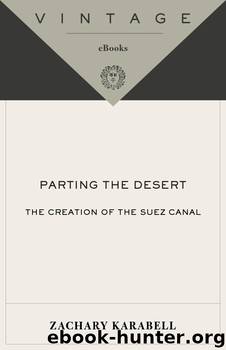Parting the Desert by Zachary Karabell

Author:Zachary Karabell [Karabell, Zachary]
Language: eng
Format: epub
ISBN: 978-0-307-56607-2
Publisher: Knopf Doubleday Publishing Group
Published: 2003-09-16T04:00:00+00:00
CHAPTER THIRTEEN
THE CORVÉE
THE FRENCH EXPRESSION “Quelle corvée!” translates as “What a drag!” The actual corvée in nineteenth-century Egypt was that and more. Hardly unique to Egypt, the corvée has been used in countless countries for as long as human history has been recorded. Most of the wonders of the ancient world were built through forced labor. Even the temples of the Greeks were constructed by laborers who were not given the option of refusing to haul the tons of stone and thousands of bricks needed to construct a Parthenon. The Great Pyramids at Giza, the Great Wall of China, the temple of Angkor Wat in Cambodia—all were the products of hundreds of thousands of peasants who were corralled by armies of the state, taken to the sites, and put to work. Whether they survived was not a primary concern.
One of the byproducts of the English revolutions of the seventeenth century, the American and French revolutions of the eighteenth century, and the emergence of liberal ideas in the nineteenth century was that slavery and forced labor came under attack. Human bondage was difficult to reconcile with the principles of liberty and freedom. The British officially outlawed the slave trade in 1807. In France, the Society for the Abolition of Slavery agitated for decades before it was finally victorious, during the brief Second Republic interregnum, in 1848. Neither of these laws actually ended slavery in the colonies held by Britain and France, and it would take continuous effort by antislavery advocates to eradicate the human trade in Africa, Asia, and even Latin America. But by midcentury it was difficult to find anyone in a position of influence in the West defending slavery, at least outside of the Southern part of the United States.
The Egyptian corvée existed in a gray zone. The peasants pressed into service were not considered property of the state or of private individuals. But the system did impose a form of temporary servitude. The workers could not come and go as they pleased. They were recruited under the threat of violence and forced to work under the threat of violence. Typically, the corvée was used for irrigation projects on the Nile. These took several months to construct, but it was simple to assemble large numbers of peasants from nearby villages. The Nile Delta, to the north of Cairo, was the most densely populated region of the country outside of the cities, and most of the dikes, dams, embankments, and sluices that needed maintenance and dredging were within a few days’ journey from even the most remote delta village. The system was further softened by an unspoken understanding that irrigation did not just serve the interests of the few: agriculture was vital for ruler and peasant alike.
Another mitigating factor was the culture itself. Slavery and the rights of man were the subject of fierce debates in Western Europe at the time, but the same was not true in Egypt or anywhere else in the Near East and Africa. The slave
Download
This site does not store any files on its server. We only index and link to content provided by other sites. Please contact the content providers to delete copyright contents if any and email us, we'll remove relevant links or contents immediately.
| Africa | Americas |
| Arctic & Antarctica | Asia |
| Australia & Oceania | Europe |
| Middle East | Russia |
| United States | World |
| Ancient Civilizations | Military |
| Historical Study & Educational Resources |
Empire of the Sikhs by Patwant Singh(23020)
The Wind in My Hair by Masih Alinejad(5056)
Rise and Kill First by Ronen Bergman(4739)
The Templars by Dan Jones(4656)
The Rape of Nanking by Iris Chang(4165)
12 Strong by Doug Stanton(3525)
Blood and Sand by Alex Von Tunzelmann(3164)
Babylon's Ark by Lawrence Anthony(2647)
The History of Jihad: From Muhammad to ISIS by Spencer Robert(2599)
No Room for Small Dreams by Shimon Peres(2343)
The Turkish Psychedelic Explosion by Daniel Spicer(2330)
Inside the Middle East by Avi Melamed(2325)
Gideon's Spies: The Secret History of the Mossad by Gordon Thomas(2319)
Arabs by Eugene Rogan(2279)
The First Muslim The Story of Muhammad by Lesley Hazleton(2245)
Come, Tell Me How You Live by Mallowan Agatha Christie(2228)
Bus on Jaffa Road by Mike Kelly(2123)
Kabul 1841-42: Battle Story by Edmund Yorke(2003)
1453 by Roger Crowley(1994)
